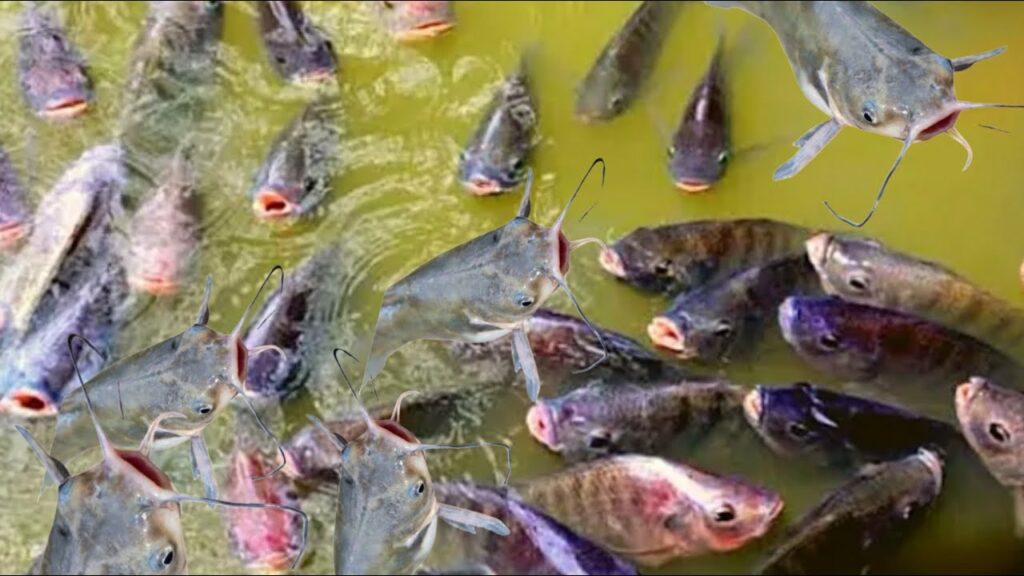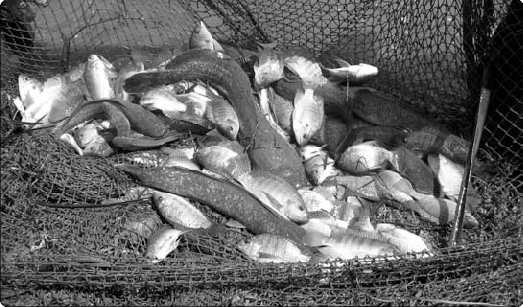Fish polyculture is an efficient and sustainable method of raising fish, which more and more fish farmers are practicing worldwide. This article discusses what fish polyculture is, how to select the ideal species of fish for polyculture, the benefits versus challenges, and a detailed case study considering tilapia and catfish. If you intend to do polyculture or are seeking to improve your fish polyculture system at the farm, then this comprehensive guide is all you will need.
What is fish polyculture?

Fish polyculture, also commonly called multi-species aquaculture, is the rearing of two or more species of fish together in the same culture unit at a given time. The main idea behind polyculture is to stock different ecological niches in a pond or tank and maximize the utilization of resources, including food, space, and light, so that productivity and profitability of the farm may increase.
Note; An ecological niche refers to the role of a species in its habitat. It’s like the specific “job description” that a species has within its environment. This includes how it interacts with other organisms, what it eats, where it lives, and how it survives and reproduces. Imagine it as the unique spot a species occupies in the grand ecosystem puzzle!
In the polyculture system, each species occupies a specifically unique ecological niche, hence minimizing direct competition for food and habitat. For example, one fish species might feed at the bottom of the pond, while another is feeding in the middle water column, and yet another at the surface. Complementary feeding behaviors minimize wastes and ensure that the whole ecosystem within the pond is well utilized.
Polyculture is outstandingly good at increasing fish production, improving water quality, and balancing the ecosystem in the farming environment. It can be done in ponds, cages, and tanks; thus, it has wide applicability in aquaculture settings and is a very versatile technique for fish farmers.
How to choose right fish species for polyculture
The most important factor in a polyculture system is the proper combination of fish species. The fish species chosen have to display complementarity in terms of food habits, growth patterns, and environmental tolerances to grow in harmony with one another. Some major consideration to have in mind on how to choose fish species for a polyculture are described below:
A. Feeding habit/Trophic level
The most critical factor in fish polyculture is the feeding behavior of the species involved. Species should occupy different trophic levels to avoid direct competition for food. For instance:
Supplementary feeders: These are fish that mainly feed on organic detritus, without wholly depending on it. Tilapia is a common supplementary feeder in the polyculture system. Tilapia are also surface feeders, which reduces competition for food with other chosen candidates for polyculture.
– Middle Column Feeders: These fishes take up food as suspended particles and organisms in the middle column of the water. Catfishes often fall under this category.
– Bottom Feeders: These are fish, which ingest detritus, insects, and other organic matter lying at the bottom of the pond. Common carp is a typical bottom feeder used in polyculture.
Where possible, the selection of species occupying different feeding niches will optimize the use of available natural food resources, allowing for the reduction of the supplementary feed.
B. Growth rates and compatibility
Compatibility in the fish species growth rates is also important for consideration. A fish growing at a very fast rate is most likely going to outcompete the rest, thus leading to an imbalanced system.
It is possible so that the fish will not be stressed and hurt because of an unnecessary behavioral mismatch and level of aggression.
C. Environmental tolerance
Different species of fish have varying tolerances in water quality parameters, such as temperature, pH, dissolved oxygen, and salinity. The species must be compatible enough so that environmental limits on the different species may be compatible within the same environment used for rearing. As an example, both tilapia and catfish are tolerant to the entire range of water conditions, therefore, such fish will do perfectly well in polyculture.
D. Market demand and Economic considerations
They should also consider the economic value of the fish species and the existing market demand. A farmer should go for fish species that have high market value and their demand is constant in the local markets. In addition, you should also consider the cost of fingerlings, feeds, and other inputs to check their economics.
Benefits of fish polyculture
Fish polyculture has several advantages that make it very alluring to fish farmers. Some major advantages include:
1. Higher productivity
One can obtain higher overall yields with several fish species reared in the same culture unit of water than with monoculture. Since different fish species occupy different ecological niches with varying feeding habits, space and resources are efficiently utilized.
2. Improved water quality
A diverse number of fish species in the same unit creates a balanced ecosystem which remediates composition of the water. For example, species like tilapia, which is a filter-feeder, would reduce phytoplankton, while bottom feeders such as catfish minimize organic wastes at the bottom of the pond, thereby maintaining the balance in the water quality and hence giving less need for frequent exchange of water or even chemical treatment.

3. Diversified income
Such diversification in the kinds of species reared provides farmers with multiple sources of income streams. In case any particular type of fish gets affected by market fluctuation or disease, it wouldn’t solely reduce the farmer’s source of income as other species will replace it and cover the returns. This approach of diversification limits the level of financial risk undertaken and is more likely to provide stability for the farming operation.
4. Ecological balance
Polyculture promotes ecological balance and hence establishes an environment unlike a culture system but similar to that of the natural aquatic ecosystems. Each species contributes to the health of the other in the pond environment. Herbivorous species can for instance control excessive growths of aquatic vegetation, while carnivorous species can control the population of smaller fish or invertebrates. This has helped fish farmers reduce size variations in tilapia at the time of harvest since the young fish that are produced are eaten by catfish ensuring harvest of the initially stocked tilapia.
5. Environmentally friendly
Fundamentally, with the balanced ecosystem and effective use of resources, this gives less environmental impact compared to monoculture. This means there is less need for inputs in terms of feeds, fertilizers, and other chemicals, hence making polyculture a more viable and environmentally friendly way of fish farming.
Problems of fish polyculture
Though fish polyculture offers several advantages, certain problems are associated with the system also. Hence, farmers should be aware of these issues for the successful implementation and management of a polyculture system.
1. Species compatibility problems
One of the major limitations of polyculture is to bring together compatible species in terms of feeding habits, growth rates, and behavior. If incompatible species are put together, there is a likely resource competition where aggression and stress are likely to originate from the inability of fish to coexist with each other. Mostly, this limitation affects fish health and growth adversely.
2. Disease control
This often leads to issues with disease management in rearing multiple species together. Various species may be more or less susceptible to disease outbreak, making diagnosis of, and treatment for, infections hard. Also, diseases are passed much more easily from one organism to another in polyculture systems. This will thus pose the need for strict monitoring and management practices.
3. Water quality management
While polyculture will enhance the self-purification in water, it requires monitoring and management with equal carefulness. There will be fluctuations in water quality parameters like ammonia, nitrate, oxygen levels due to several species producing different wastes. The farmer has to continuously monitor the water quality to keep the environment healthy.
4. Feed management
Challenges here include ensuring the right type and quantity of feed for multi-species. In ensuring that no certain species goes hungry, the farmers also have to guard against over-feeding that could lead to water pollution. This may be further achieved through the use of either different feed types or different feeding strategies for different species.
5. Market risks
While polyculture offers income diversification, it exposes the farmer to market risk for the several species. If one species in the farm shows low market demand or has price tugs, this would affect the profitability in the whole operation. For this purpose, farmers have to keep aware of the trends in the markets and be ready to switch production strategies when need be.
CASE STUDY: Tilapia and catfish polyculture

To have a realistic illustration about fish polyculture, a detailed case study on polyculture rearing of tilapia and catfish is presented here. This combination is commonly implemented in most of the parts of the world because of the complementary nature of these two species.
Background
This is a case study of a fish farmer in East Africa rearing fish by polyculture in a ½ -hectare (5000 Sq. m) fish pond. The farmer has opted to raise Nile tilapia and African catfish together at a stocking density of 5 fish/Sq.m. The water supply to the pond and draining system were well fixed, and the water quality parameters are constantly monitored to ensure optimum conditions.
Species selection and stocking
He chose to rear these two species because of their contrasting feeding behaviors and environmental tolerance. The case in point is that of the Nile tilapia, which is mainly herbivorous, feeding on algae and plankton. On the other hand, the African catfish is an omnivorous bottom feeder and consumes almost all kinds of organic matter, including small fish and insects.
This was done to keep the ecosystem in balance; the stocking density was well planned. The farmer thereafter stocked 20,000 tilapia fingerlings and 5,000 catfish fingerlings in the pond. According to the growth rates and expected market sizes for the two species, a stocking ratio was done.
Note: The fish was not stocked at the same time: Tilapia fingerlings were stocked first, then catfish fingerlings were introduced about 3 months later. By stocking tilapia first, they can establish themselves and reach a size that makes them less vulnerable to predation by catfish. If catfish were introduced at the same time or before tilapia, they might prey on the smaller tilapia fingerlings, leading to significant losses.
Feeding and management
So he made a feeding regime that was friendly to both species. The tilapia depended on plant-based feed with commercial pellets added while catfish required food higher on proteinaceous nutrient content that would help them to grow healthily. He brought natural food into the pond through organic manuring. Organically manuring the pond, fertilized it and in turn allowed phytoplankton, and zooplankton to grow.
To maintain good water quality, he regularly monitored water quality, for parameters such as dissolved oxygen, pH, and ammonia levels. He regularly exchanged water and observed good feeding mechanisms like feeding by response and giving fish the right amount of feed respective of their growth stage.
Growth and harvest
After 7 months of culture, the average weight of the tilapia was 450 gm, while that of the catfish was 1 kg. The farmer scheduled a harvesting of both species at the same time to fully utilize this pond for maximum benefit.
Economic and environmental consequences
The polyculture system was therefore productive and economically efficient; the farmer received a good profit from simultaneously selling tilapia and catfish. With the reduction in the financial risk associated with diversified income, the balance of the ecosystem kept the need for chemical treatments and water exchange down.
Environmentally, it indicated that the system would be sustainable, since the complementary feeding behavior between tilapia and catfish in this system maintained water quality with less accumulation of wastes. This was because the presence of tilapia as a surface feeder controlled algal growth in the pond while catfish, being a bottom feeder, avoided accumulation of the organic wastes in the bottom of the pond. It is this overall intrinsic balance which lessened the impact of the farming operation on the pond ecosystem and ultimately was a benefit to the natural system.
Take Home;
Polyculture is also an efficient and viable method of fish farming because it maximizes the use of resources, increases productivity, and reduces the environmental impact of fish polyculture. Fish farmers can establish polyculture systems that are both profitable and ecologically sound by careful selection of compatible species, good feeding and water quality management, and awareness of the potential problems that may arise.
The case study example on tilapia-catfish polyculture demonstrates its practical application in view of the added advantages of increased yields, diversified income, and improved water quality. Fish polyculture is, therefore, one such promising and versatile approach for the entrepreneur who intends to engage in aquaculture or desires to diversify his current enterprise.
Polyculture, therefore, will be just one of the many sustainable ways through which such demand shall be met globally without negatively affecting aquatic environment.






